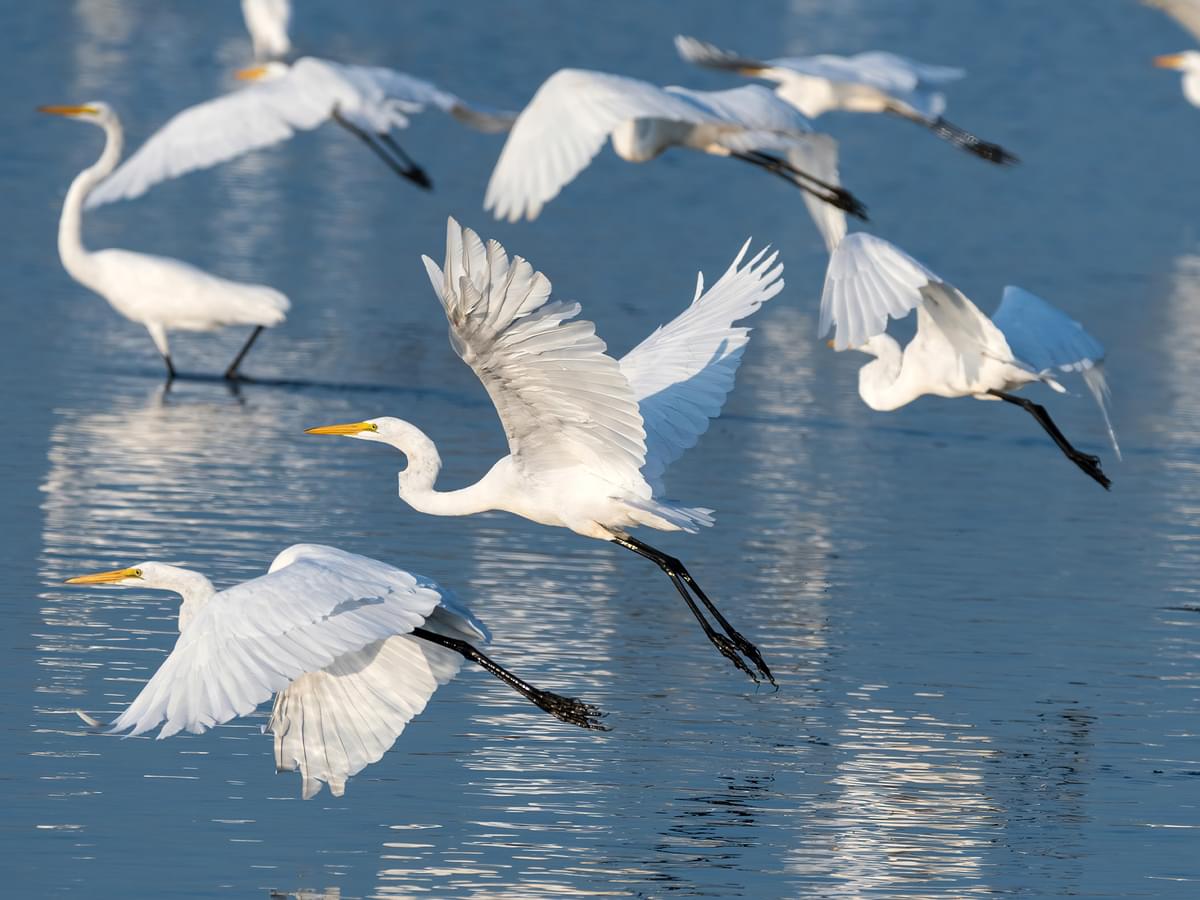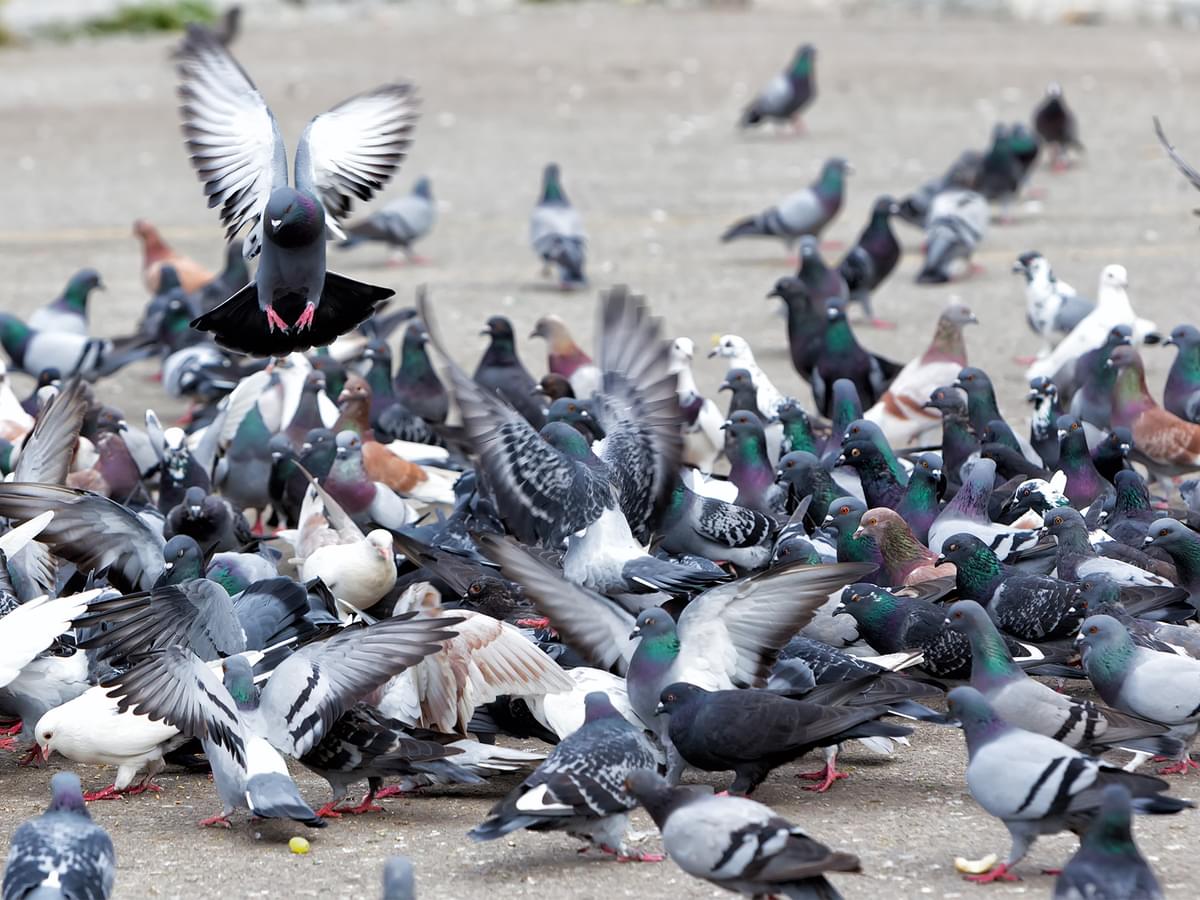Flocking Behavior

Thousands of starlings flying together in spectacular murmurations on winter evenings are one of nature’s most elaborate examples of flocking behavior.
But many other birds also form flocks to forage, roost, or migrate together. Mixed-species feeding flocks regularly form after the breeding season ends, with multiple benefits from associating as part of a larger group.
Keep reading about how flocking together can offer protection and security to individual birds.
Unity in Flight
Particularly in winter months, large gatherings of birds can be seen both on the ground and in the air. V-shaped formations of geese overhead are a familiar sight as fall progresses, as they embark on their annual migration flights.
Even common city-dwelling birds, including rock pigeons and sparrows, are usually accompanied by numerous other birds of the same species, both in flight and when foraging for food.
By studying the flocking behavior of bird species, we’re able to learn more about how birds interact with each other. Understanding how flocks move and are organized, the roles of individuals within a larger flock, and why some birds may choose not to join a flocking group gives us valuable insight into the structures of bird society and the hierarchies of ecosystems in their natural habitats.
‘Pecking orders’ help us to understand and predict which birds can live alongside each other without conflict and how integration with a larger group of same or mixed-species birds will aid their survival in both the long and short term.

Thousands of starlings flying together in spectacular murmurations on winter evenings are one of nature’s most elaborate examples of flocking behavior
Understanding Flocking Behavior
By studying flocks of birds feeding and roosting together, it’s possible to begin to comprehend more about why birds behave in certain ways and the factors that influence social interaction.
Understanding why some birds form or join flocks and why others remain solitary helps us to identify patterns that influence survival and strategies different birds use to avoid predators or access the best feeding grounds.
What is Flocking?
Most birds are less than sociable during the breeding season, concentrating on raising their own chicks with minimal contact with other birds of any species. However, for many species, once their young have fledged, things change, and they may begin gathering in larger groups. Mixed flocks offer effective protection against predators, with smaller birds able to take shelter among larger birds.
One of the largest known flocks gathers for roosting on a nightly basis in Yakima, Washington, where up to 150,000 individual American robins assemble as night falls. During migration, up to a million Amur falcons can be spotted moving from South Asia to Africa after breeding each year.
Not all flocks are vast or consist of just one single species. Smaller, mixed flocks are also common among woodland birds, such as tits, treecreepers, and goldcrests. Some mixed flocks are known to fly and roost together but separate when feeding particularly different finches.

Pictured: An Amur Falcon. During migration, up to a million Amur falcons can be spotted moving from South Asia to Africa after breeding each year
Reasons Behind Flocking
Flocking is a common bird behavior but is not triggered by one single factor. The reasons why some birds flock together to feed, sleep, or travel and why others remain solitary throughout the year, are the subject of much research.
The three key reasons that drive flocking behavior are safety in numbers, better feeding efficiency, and access to abundant food resources.
Safety in Numbers
Gathering closely with other birds offers a huge advantage of staying safe from predators. A lone bird foraging on the ground is easy prey for a focused raptor with a keen eye and refined hunting skills.
Multiply this lone bird by a hundred, or even by ten or twenty, and hunting success becomes less guaranteed. In larger flocks, it becomes harder to zone in effectively on an individual, and flock members serve as an early-warning alert system, by flying up or calling when a threat is detected.
In mixed species flocks, individual birds are less likely to be eaten when surrounded by alternative prey for possible predators, with birds using each other for camouflage, protection, and security.
If birds feel safer as part of a flock, this may naturally lead them to feed more efficiently, as they are able to concentrate on eating rather than being in a high state of vigilance against possible attacks.

Pictured: Flock of Greater Flamingos. If birds feel safer as part of a flock, this may naturally lead them to feed more efficiently
Enhanced Foraging Efficiency
Foraging on the ground for food is when flocks of birds are at their most visible. Flock size increases as other nearby birds join after spotting groups feeding busily and successfully in a yard, park, or woodland floor.
Foraging flocks are particularly common among insectivorous species, moving from place to place in response to the availability of food.
Within a flock, individual birds communicate with each other through calls and body language to share information about food availability and location. This ‘signposting’ allows birds to forage more efficiently, as less time and energy are spent searching for food themselves, they can simply follow the crowd and graze as they go.
Larger flocks of birds are able to spread out and cover more ground than birds feeding individually, increasing the likelihood of a decent food source being found.

Pictured: Group of Barnacle Geese foraging together
Dynamics of Flock Formation
We’ve all seen groups of birds feeding together or flying overhead together, en-route to roosting sites or wintering grounds. But have you ever wondered how these groups actually form, and how they know which direction to head in or when to land?
We’ll be taking a look at the group dynamics of flocks and discovering whether there are natural or nominated leaders and followers, so keep reading if you’d like to find out.
Swarm Intelligence
Flocks may initially start to gather in response to a shared resource, including foraging grounds with plenty of food resources, a roosting site with suitable shelter, or migration to breeding grounds with a wealth of ideal nesting sites.
Species, including pigeons and starlings, are especially social and form large feeding flocks.
Bird flocks rely on a phenomenon known as ‘swarm intelligence’ which allows them to work together in a coordinated manner to reach a destination or find a foraging site.
Swarm intelligence develops from interactions and cohesion between the individual members of a flock, by responding to the movements of the birds closest to them. This causes a ripple effect that spreads throughout the entire flock, leading to large-scale coordinated movements.

Species, including pigeons (pictured) and starlings, are especially social and form large feeding flocks
Leading and Following
Swarm intelligence in a flock of birds does not rely on there being one dominant leader or a hierarchy of senior flock members giving out instructions on where to fly or where to land.
Instead, the collective intelligence of the entire group is what makes it effective and leads to en-masse decision-making, with all flock members playing their part.
However, older or more experienced birds can influence the actions of an entire flock. They have the advantage of a better understanding of environmental factors and landscapes, which is particularly helpful when flying or foraging alongside younger flock members.
During long flights, members of a flock regularly change their position within the group, allowing them to briefly rest or use up less energy when airborne.
Birds in the center of a flock can afford to be less vigilant than those around the edges, and will regularly swap places to allow others to take a turn and share the responsibilities.
This is also true when foraging on the ground or roosting overnight, with those at the heart of the group more protected than those further out.

Pictured: A flock of Eurasian Wigeons during their migration
Flocking and Migration
Nearly 2000 bird species are long-distance migrants, spending winter months hundreds or thousands of miles away from their spring breeding grounds.
Ahead of migration, sizable flocks of birds may start to assemble, before taking to the skies together and undertaking their journeys and stopovers en masse.
Migrating together has many benefits for birds, including energy conservation and improved chances of survival when crossing oceans or seas.
Migration in Flocks
Migration puts birds through a significant amount of stress and physical exertion each year, and the accompanying risk of predation or perishing over vast bodies of water or in severe storms presents a very real danger.
Flying as part of a flock can help birds reduce these pressures and give them a greater chance of arriving on their wintering grounds or back in nesting territories safely.
Flight formation is also a key factor in a successful migration, with the famous V-formation seen in migrating geese a great example of how being part of a flock benefits birds traveling between their seasonal habitats.
A V-shaped formation makes it easier for birds to maintain visual contact with the rest of their group, making journeys less stressful. When birds reach stopover points together, they also benefit from the advantages of feeding and foraging as part of a large group, spending less energy when they refuel ahead of their onward flight.
Birds at the front of a migrating flock use up more energy than those in positions further back and rotate among themselves regularly to avoid fatigue. Birds further back in a V-formation benefit from the updraft and lift created by the wings of the birds in front, and therefore do not need to expend as much energy when flying.

Flight formation is also a key factor in a successful migration, with the famous V-formation seen in migrating geese
Summary
Flocking is an instinctive behavior in many bird species that allows birds to forage for food more efficiently and benefit from using less energy when migrating or roosting overnight.
Safety in numbers leads to a lower risk of predation, with birds less likely to successfully be caught when in a larger group than when feeding or perching individually.
Flocks follow an intuitive pattern of swarm intelligence rather than being led by a dominant ‘leader’, with all flock members interacting with their nearest flockmates. Flock members swap positions when fatigue sets in and benefit from the birds around them for protection, warmth, and energy conservation.
There’s no chief navigator or orchestrator of the streamlined V-shapes formed by migrating geese or the undulating murmurations of starlings, but instead a highly effective and reliable set of collective movements from individuals working together but motivated by their individual survival.